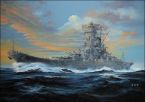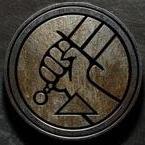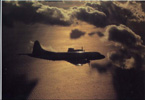Sardaukar
Posts: 9847
Joined: 11/28/2001
From: Finland/Israel
Status: offline

|
Why...easy question..Brewster model 239 in Finnish service...
From Wiki:
The fighter was never referred to as the Buffalo in Finland; it was known simply as the Brewster, or sometimes by the nickname Taivaan helmi ("Sky Pearl") or Pohjoisten taivaiden helmi ("Pearl of the Northern Skies"). Other nicknames were Pylly-Valtteri ("Butt-Walter"), Amerikanrauta ("American hardware" or "American car") and Lentävä kaljapullo ("flying beer-bottle"). The 44 Brewsters used by the FAF received the serial numbers BW-351 to BW-394. It appears the workmanship of the Finnish airframes was also better than those produced later; this was a common phenomenon as the aircraft factories were manned by a less-skilled workforce after the start of World War II.
In the end, the Brewster gained a reputation as one of the most successful combat aircraft ever flown by the Finnish Air Force. In service during 1941-1945, the Brewsters were credited with 496 Soviet and German aircraft destroyed, against the loss of 19 Brewsters: a victory ratio of 26:1. However, the substantiation of this claim on German and Soviet records is so far incomplete, and all claims have not been managed to be connected on actual losses (as of 2007).
Quite good explanation why:
http://www.warbirdforum.com/faf.htm
Q: Why did the Finns achieve so much with the Buffalo?
A: First off, the Finnish Brewsters weren't Brewster Buffaloes, or Brewster 339's, or F2A-2, which were very bad fighters. They were Model 239's much closer to the original USN F2A-1, which were reported to be delightful to fly. Finnish nickname "Taivaan Helmi" "Pearl of the Skies" reflects this. Also, Finnish Brewsters had reflector sights and reliable armament of three heavy machine guns and one rifle-caliber mg. (later on four heavy MG's) and seat armour.
The Finnish Air Force also used innovative modern air combat tactics, such as largely relying on finger four / Thach Weave / Schwarm, whatever you call it, against doctrinal Soviet tactics, such as using three plane flights and "Spanish circle" described later on. In 1941 many of the Finnish Buffalo pilots had had combat experience during the Winter War, and air combat tactics were modified and developed. Mock dogfights were made against captured russian planes. Training with Brewsters hadn't been so good as it might have been, since the severe shortage of aviation fuel in 1940-1941.
The quality of Soviet planes in 1941, when the best kill ratio 67.5 - 1) was achieved, was lower than Brewsters, most common types being used were SB-2, DB-3, I-16 and I-153.
Finally, there was element of luck. The fighter squadron the Brewsters were in most of the war, 24, was commanded by an excellent commander, Major G. Magnusson, a great organizer and tactician who is considered to be "Grand Old Man" of the Finnish fighter aviation. By almost sheer luck, some of the finest pilots of the Finnish Air Force were in the Brewster Squadron when the war started, such as Hans Wind, Ilmari Juutilainen, Joppe Karhunen and Lauri Nissinen, each one of them later on gaining huge kill numbers also with Messerschmitt 109G-2's and G-6's.
The Brewsters probably could have made even more kills, but the Finnish fighter control system during the Brewster's golden age in 1941-42 was abysmal. For an example, sometimes the alert messages were only somekind like this: "Village of Inkeroinen is being bombed" and arrived as much as 15 minutes too late. But by the summer 1944 it was excellent. Criticism against Finnish ground control system and FAF brass in general has been extremely harsh by Joppe Karhunen, a Brewster ace and an aviation historian.
Everybody is always talking about plane vs. plane statistics. It's more about those who fly them, if plane is even same "generation" and comparable.
< Message edited by Sardaukar -- 12/1/2007 1:03:19 PM >
_____________________________
"To meaningless French Idealism, Liberty, Fraternity and Equality...we answer with German Realism, Infantry, Cavalry and Artillery" -Prince von Bülov, 1870-  |
 Printable Version
Printable Version



























 er....sorry. couldnt resist.
er....sorry. couldnt resist. 


 It hasn't. I was a victim myself a couple of months ago. But that doesn't excuse improper and inflamatory phrases that have nothing to do with the argument. All I ask is keep it a clean fight. Try and keep it on topic. And watch your @##$%^ language.
It hasn't. I was a victim myself a couple of months ago. But that doesn't excuse improper and inflamatory phrases that have nothing to do with the argument. All I ask is keep it a clean fight. Try and keep it on topic. And watch your @##$%^ language. 
 New Messages
New Messages No New Messages
No New Messages Hot Topic w/ New Messages
Hot Topic w/ New Messages Hot Topic w/o New Messages
Hot Topic w/o New Messages Locked w/ New Messages
Locked w/ New Messages Locked w/o New Messages
Locked w/o New Messages Post New Thread
Post New Thread